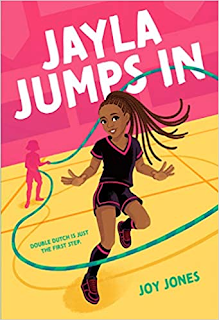Joy Jones is the author of Jayla Jumps In, a new middle grade novel for kids. Her other books include Tambourine Moon and Fearless Public Speaking. She lives in Washington, D.C.
Q: How did you come up with the idea for Jayla Jumps In, and for your character Jayla?
A: I jump Double Dutch in my real life. Not just when I was a little girl - I’m still doing it even though I’m at the ripe old age of — well, we won’t go there.
I am the founder of DC Retro Jumpers, which started as a recreational outlet for women who wanted to jump Double Dutch. Now, we offer demonstrations and classes all over town for everybody: grandmothers, little girls, grown men, teenaged boys. In 2018, we were hired as cultural ambassadors to Russia, presenting Double Dutch demonstrations in Moscow, St. Petersburg, and Belgorod.
It was my agent who suggested that I do a middle-grade novel about Double Dutch. I was dubious at first. I had already written a play, Outdoor Recess, about adults jumping rope. Did I have another story about Double Dutch inside of me? It turns out I did.
Q: The novel takes place in Washington, D.C.--how important is setting to you in your writing?
A: I was born and raised in D.C. and I love my city. So it’s no surprise that the story is set in D.C. The main character lives in Hillcrest, a gem of a neighborhood in SE. I got to know Hillcrest when I started working at the neighborhood library there.
Q: What do you think the book says about the importance of exercise for kids (and adults)?
A: There’s so much joy in being able to move your body! Exercise isn’t something to do because it’s “good for you” like taking vitamins. Exercise feels good.
I like doing yoga, swimming, dancing - at least when there’s no pandemic to contend with. Currently, I take walks outdoors and do stretches indoors. Every now and then, I jump Double Dutch since it’s an activity where you can keep a degree of distance.
My wish is that as a result of reading Jayla Jumps In some young people get motivated to play outside. Video games are fun, television is fine, social media, fantastic. But being able to put your body in motion and use your own imagination to enjoy yourself - ah…
Q: Did you know how the novel would end before you started writing it, or did you make many changes along the way?
A: I need to know the destination of a story before I begin it. That doesn’t mean I have to know all the points along the way, but I need a sense of what the story is about and the general direction of where the protagonist is going. I know that there will be changes along the way; some plot devices won’t work, some characters will have to be reworked, some ideas won’t play out.
When the editor brought her perspective to the manuscript, still other changes had to be made. I learned a long time ago that much of writing is rewriting.
For Jayla Jumps In, I knew I wanted Double Dutch to be multigenerational, just like DC Retro Jumpers. What I didn’t know was that I had to change my main character’s name. She started out as Kayla.
After I finished the first draft, I began work on the book proposal. Part of the process is to research other books similar to your own. There was another book about Double Dutch for kids - and the main character’s name was Kayla! I did not know that author nor had I read her book, but it was curious to me that we both wrote on the same topic and had a protagonist with the same name. The plots are much different, however.
Q: What are you working on now?
A: I have several projects underway. I just finished a picture book biography called Sound Is Ready, about the first African American to win two consecutive Academy Awards. Russell Williams was honored for his sound engineering work on Glory and Dances With Wolves.
I’m also writing, along with Tom Adams, an adult biography about the marriage of Bill & Lois Wilson, the founders of the 12-Step recovery movement.
And I’m at work on another children’s novel called Walking the Boomerang.
Q: Anything else we should know?
A: If you’re a writer, join a writing group. For me, that has made me disciplined. I’m in a group of six writers who meet monthly. Knowing I have the obligation to show up and produce forced me to write when I felt lazy, write when I felt uninspired, write when I didn’t think I had anything to say. Having a deadline has proven to be a lifeline for my art.
--Interview with Deborah Kalb




















